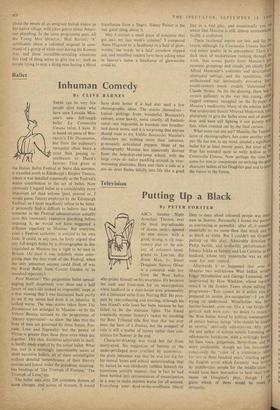Ballet
Inhuman Comedy
By CLIVE BARNES
THERE can be very few people alive today who have seen Leonide Mas- sine's new full-length ballet La Commedia Umana twice. I have. It is based on parts of Boc- caccio's The Decameron, N.4.4,s4 but from the audience's
viewpoint often bears a more than passing re- semblance to Dante's Inferno. First given at the Italian Ballet Festival at Nervi this summer, it travelled north to Edinburgh's Empire Theatre, where it was installed supposedly as the Festival's Major contribution to the art of ballet. Now obviously I regard ballet as a considerably more important art than anyone (past, present or, I would guess, future) employed by the Edinburgh Festival, so I must steadfastly refuse to be bitter.
personally find it difficult to believe that had someone in the Festival administration actually seen this immensely expensive plaything before ordering it, he would not have suggested a different repertory to Massine. But everyone, even a Festival authority, is entitled to his own taste. It could, in any case, be fairly argued that any full-length ballet by a choreographer as dis- tinguished as Massine has a right to be seen in Britain. (At least it was infinitely more enter- pising than the first week of the Festival, when the only attraction anyone could think of was the Royal Ballet from Covent Garden in its standard repertory.) Poor Massine! This gargantuan ballet spread- eagling itself shapelessly over three and a half hours of one's life looked so impossibly inept at a first viewing that I was fascinated back partly to see if my senses had done it an injustice. It looked worse. The nine stories taken from The Decameron are arranged by Massine—or by the Vittore Branca accused by the programme of `literary supervision'—to show `the idea that the lives of men are governed by three forces, For- tune. Love and Ingenuity; but the power of Virtue is greater than these three even when put together.' This idea, doubtless admirable in itself, is hardly made explicit by the actual ballet. What one sees is a seemingly interminable series of short narrative ballets, all of them unintelligible without detailed remembrance of their literary sources and linked under the grandiose, meaning- less headings of 'The Triumph of Fortune,' The Triumph of Love,' etc.
The ballet uses over 200 costumes, dozens of scene changes, and scores of dancers. It would have done better if it had also used a few choreographic ideas. The stories themselves— typical pickings from wonderful Boccaccio's cabinet, some bawdy, some courtly, all fantasti- cated—are impossible to translate into bowdler- ised dance terms, and it is surprising that anyone should want to try. Unlike Boccaccio, Massine's characters are nothing more than inhuman, grotesquely articulated puppets. Most of the choreography Massine has apparently derived from the hop-skip-and-jump school, with the large corps de ballet paddling around in ever- increasing platitudes. Here and there a solo or a pas de deux fizzles fitfully into life like a good
line in a bad play, and occasionally you at aware that Massine is still, almost somnambulta' tically, a craftsman. These incidental merits are few and far he' tvveen, although La Commedia Unrana has one real minor quality in its atmosphere. There Is 3 dark stain of meditevalism running through the work, that comes partly from Massine's turesque groupings and rituals, yet chiefly froal Alfred Manessier's costumes and descriptivelY abstracted settings, and the repetitious, vilelY orchestrated but intrinsically evocative four teenth-century music crudely 'elaborated' hY Claude Arrieu. As for the dancing, there 11'35 certain gallantry in the way this young, oftea, ragged company struggled on the fly-paper 01 Massine's mediocrity. Many of the soloists, led hi that aristocratic dancer Milorad Miskovitch, tried plaintively to give the ballet some sort of distine' tion, and were still fighting it out gamely with fate, when counted out by the final curtain.
What more can one say? Massine, the Tambut laine of choreographers, has come another cror per. He has not, to my mind, created a significa0t ballet for at least twenty years, but none of his flops has sounded quite so wetly hollow as L's Commedia Umatra. Now perhaps the time h3s come for him to concentrate on reviving the great character ballets of his Diaghilev past and to leave the future to the future.


































 Previous page
Previous page